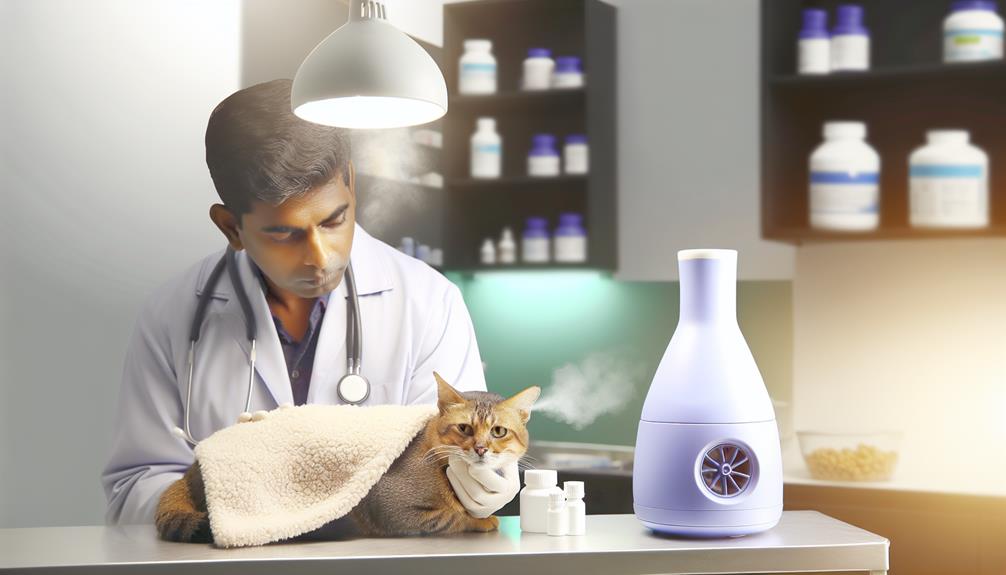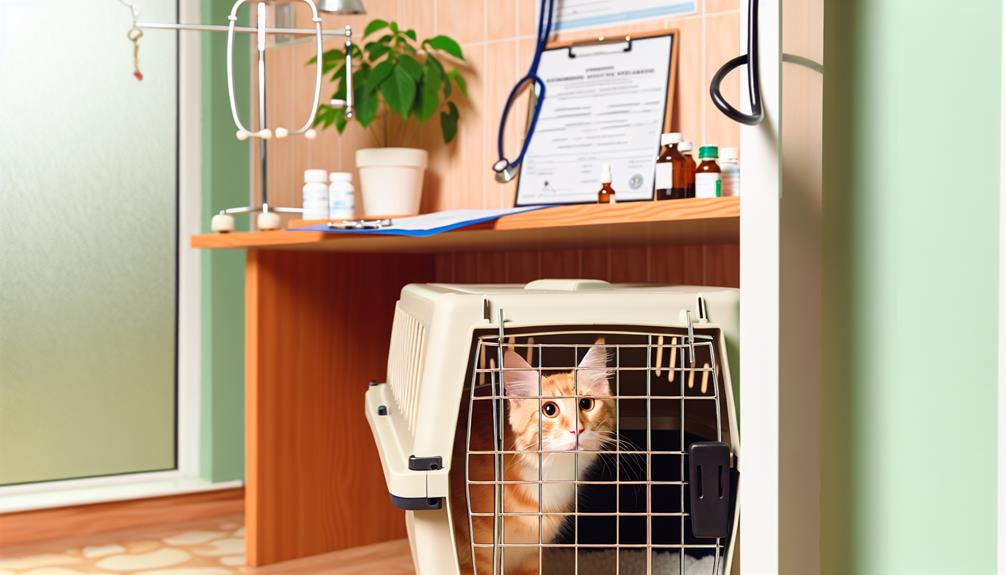You might wonder if kennel cough, a common ailment in dogs, can affect your feline friend as well. Notably, cats can indeed contract kennel cough, primarily caused by the bacterium Bordetella bronchiseptica. This highly contagious respiratory disease doesn't discriminate between species and can spread through direct contact or even airborne particles. Recognizing the symptoms in cats, such as coughing, sneezing, and nasal discharge, is essential for prompt treatment. But how exactly does this condition impact your cat's health, and what steps should you take to protect them? Let's explore further to guarantee your pet stays safe and healthy.
Understanding Kennel Cough
Kennel cough, formally known as canine infectious tracheobronchitis, is a highly contagious respiratory disease that primarily affects dogs. You'll find that this condition is caused by a complex interplay of viral and bacterial pathogens. The most common culprits include Bordetella bronchiseptica, canine parainfluenza virus, and canine adenovirus type 2. These pathogens compromise the respiratory tract, making it susceptible to secondary infections and resulting in the characteristic harsh, hacking cough.
When considering the causes of kennel cough, it's vital to recognize the role of environmental factors. High-density settings like kennels, shelters, and dog parks greatly elevate the risk of transmission. Stress, poor ventilation, and concurrent infections further exacerbate the likelihood of an outbreak. If your dog is frequently exposed to these high-risk environments, it's paramount to acknowledge the increased probability of contracting this infectious disease.
Risk factors extend beyond mere exposure to pathogens. Dogs with weakened immune systems, such as puppies, senior dogs, and those with preexisting health conditions, are particularly vulnerable. Vaccination status also plays an essential role; unvaccinated dogs or those with incomplete vaccination schedules are at a heightened risk. Additionally, the duration of exposure to infected animals and the virulence of the pathogens involved greatly influence the likelihood of infection.
Understanding these risk factors is important for implementing effective preventive measures. Vaccinations, reducing stress, and ensuring good ventilation in kennels can noticeably reduce the incidence of kennel cough. By appreciating the multifaceted causes and risk factors, you'll be better equipped to protect your dog from this pervasive disease.
Transmission to Cats
While kennel cough primarily affects dogs, you might wonder if cats can also contract this respiratory illness. Indeed, cats are susceptible to the Bordetella bronchiseptica bacterium, one of the primary pathogens responsible for kennel cough in dogs. Transmission to cats typically occurs through direct contact with infected animals or exposure to contaminated environments.
Key Points
| Risk Factor | Environmental Trigger | Transmission Method |
|---|---|---|
| Close contact with infected dogs | Crowded shelters or catteries | Direct contact or aerosol droplets |
| Shared food and water bowls | Poor ventilation | Fomites (inanimate objects) |
| Stress due to overcrowding | High humidity and poor sanitation | Airborne particles |
Risk Factors
Key risk factors for transmission include close proximity to infected dogs or other animals, shared resources like food and water bowls, and stress due to overcrowded conditions. Cats in shelters, catteries, or multi-pet households are particularly vulnerable.
Environmental Triggers
Environmental triggers such as poor ventilation, high humidity, and inadequate sanitation can exacerbate the risk of transmission. Crowded environments increase the likelihood of aerosolized droplets containing the pathogen being inhaled by susceptible cats.
Transmission Methods
The primary transmission methods include direct contact with infected animals, airborne particles, and fomites. For example, a cat might contract the pathogen by sniffing or grooming a contaminated surface or by inhaling droplets when an infected dog barks or coughs.
Symptoms in Cats

Symptoms in cats infected with Bordetella bronchiseptica can vary but often include sneezing, nasal discharge, and coughing. These clinical manifestations result from the pathogen's impact on the feline respiratory system. While coughing is a hallmark symptom reminiscent of what you might see in dogs with kennel cough, in cats, it can sometimes be less frequent but more severe, causing considerable distress.
Common Symptoms:
- Coughing: This is one of the primary cough causes and can range from mild to severe. You might notice your cat hacking or making dry, retching sounds.
- Sneezing and Nasal Discharge: These symptoms can be persistent and may lead to secondary infections if not addressed. The nasal discharge can be clear or purulent, indicating varying degrees of infection.
- Lethargy and Loss of Appetite: These are indirect symptoms but vital indicators that your cat is struggling. The impact on their overall well-being can be profound, and immediate attention is necessary.
The onset of these symptoms can be acute, developing within a few days of exposure. Typically, young kittens, elderly cats, or those with compromised immune systems are more susceptible. You'll often notice that their respiratory efforts become labored, which can be alarming. In severe cases, the infection can progress to pneumonia, necessitating urgent veterinary care.
Monitoring your cat closely for these symptoms is essential. Prompt recognition and intervention can mitigate complications associated with feline respiratory infections caused by Bordetella bronchiseptica. Always consult with your veterinarian if you observe any of these symptoms, as early treatment can meaningfully improve outcomes and reduce the risk of transmission to other pets.
Diagnosis Methods
To diagnose kennel cough in cats, you should begin with a thorough clinical signs examination, focusing on respiratory symptoms. Laboratory diagnostic tests, such as PCR and bacterial cultures, provide definitive confirmation by identifying the specific pathogens involved. These methods guarantee an accurate diagnosis, guiding effective treatment strategies.
Clinical Signs Examination
Identifying kennel cough in cats requires a thorough clinical examination, with a focus on recognizing specific clinical signs indicative of the condition. When evaluating your cat's pet health, you'll need to be vigilant about observing changes in its feline respiratory system. The clinical signs of kennel cough in cats can be subtle but are essential for early diagnosis and effective management.
During a clinical examination, a veterinarian will look for:
- Persistent Cough: Unlike the occasional cough, a persistent cough is a primary indicator. It's usually dry and hacking, often described as a "honking" sound.
- Nasal Discharge: Clear or purulent nasal discharge can be a sign of an underlying respiratory infection. This symptom, combined with coughing, should raise immediate concern.
- Lethargy and Fever: Cats with kennel cough may exhibit reduced activity levels and a noticeable increase in body temperature, signaling an ongoing infection.
These signs are not exclusive to kennel cough but are prominent indicators that warrant a closer look. A thorough clinical examination is critical in differentiating kennel cough from other feline respiratory diseases. By promptly recognizing these symptoms, you can take the necessary steps to guarantee your cat receives the appropriate veterinary care.
Laboratory Diagnostic Tests
Recognizing the clinical signs of kennel cough during a thorough examination is just the first step. To definitively diagnose the condition, you'll need to employ various diagnostic techniques and laboratory procedures. These methods are essential for differentiating kennel cough from other respiratory ailments.
First, consider polymerase chain reaction (PCR) testing. This highly sensitive technique amplifies the DNA of pathogens, making it easier to detect the specific causative agents of kennel cough, such as Bordetella bronchiseptica. PCR is particularly effective due to its rapid turnaround and high specificity.
Another valuable diagnostic tool is bacterial culture and sensitivity testing. By culturing a sample from the respiratory tract, usually obtained via oropharyngeal swabs, you can identify the bacterial species involved and determine the most effective antibiotics for treatment. This method, while reliable, takes longer than PCR and requires specific laboratory conditions.
Serology can also be utilized, especially for detecting antibodies against Bordetella bronchiseptica. However, this method is less commonly used due to its lower sensitivity and specificity compared to PCR.
Lastly, radiography might be conducted to assess the extent of respiratory involvement. These diagnostic techniques and laboratory procedures will guide you toward an accurate and thorough diagnosis.
Treatment Options

When addressing treatment options for kennel cough in cats, it is essential to understand that the approach can vary based on the severity of the symptoms and the underlying cause. Mild cases often resolve with supportive care and home remedies, while more severe cases may necessitate medical intervention.
Home Remedies and Natural Treatments:
- Humidity and Hydration: Increasing humidity using a vaporizer and ensuring your cat remains well-hydrated can relieve respiratory discomfort.
- Nutritional Support: A diet rich in nutrients and antioxidants can bolster the immune system. Consider adding a small amount of honey to their water, as it has soothing properties for the throat.
- Rest and Isolation: Minimizing stress and isolating the cat from other animals can prevent the spread of infection and promote faster recovery.
If symptoms persist or worsen, a visit to the veterinarian is imperative. Antibiotics may be prescribed if a bacterial infection is suspected, while antiviral medications are indicated for viral infections. In cases of severe respiratory distress, corticosteroids or bronchodilators might be necessary to reduce inflammation and open airways.
Emotional Considerations
- Watching your cat struggle to breathe is heart-wrenching.
- Not knowing how to help can evoke feelings of helplessness.
- The worry about your cat's health can be overwhelming.
It's important to monitor your cat closely and seek veterinary advice if there's any doubt about their condition. Quick intervention can prevent complications such as pneumonia, which can be life-threatening. By combining home remedies and natural treatments with professional veterinary care, you can provide thorough support for your feline friend's recovery.
Prevention Tips
To minimize the risk of kennel cough in your cat, prioritize regular vaccinations, as these are essential for enhancing immunity against Bordetella bronchiseptica. Additionally, maintaining stringent hygiene and cleanliness in your cat's environment greatly reduces exposure to pathogens. Implementing these evidence-based strategies effectively protects your feline from respiratory infections.
Vaccination for Cats
Vaccination stands as one of the most effective preventive measures to protect your cat from various infectious diseases, including potential respiratory infections often referred to as kennel cough. Cat vaccination specifically targets pathogens responsible for feline respiratory illnesses, considerably reducing the risk of severe complications. As a cat owner, it's vital to adhere to a vaccination schedule recommended by veterinarians to guarantee your pet's ideal health.
Key Benefits of Cat Vaccination:
- Disease Prevention: Vaccines stimulate your cat's immune system to produce antibodies, effectively guarding against infections like feline herpesvirus and calicivirus.
- Community Health: By vaccinating your cat, you're also contributing to the overall health of the feline community, preventing outbreaks of contagious diseases.
- Peace of Mind: Knowing that your pet is protected allows you to enjoy their companionship without the constant worry of potential illnesses.
Evidence-based studies demonstrate that regular vaccination minimizes the incidence of feline respiratory infections. It's important to consult your veterinarian to tailor a vaccination plan that suits your cat's specific needs. Remember, a proactive approach in maintaining your cat's health through vaccination can save you from future distress and costly treatments.
Hygiene and Cleanliness
Maintaining impeccable hygiene and cleanliness is essential for preventing the spread of respiratory infections like kennel cough in cats. Effective grooming practices not only enhance your cat's overall well-being but also play a critical role in mitigating the risk of infectious diseases. Regular brushing helps remove loose fur and debris, reducing the likelihood of pathogens adhering to your cat's coat. Additionally, cleaning your cat's bedding, litter box, and feeding areas with disinfectants minimizes exposure to harmful microorganisms.
Environmental cleanliness is another cornerstone in preventing kennel cough. Make certain that your home, especially areas where your cat frequents, is kept clean and well-ventilated. Regularly vacuum carpets, mop floors, and sanitize surfaces to eliminate potential contaminants. Pay special attention to high-touch areas such as doorknobs and cat carriers, which can harbor infectious agents.
Moreover, if multiple pets are present, segregate sick animals to prevent cross-contamination. Use separate grooming tools and feeding bowls for each pet, and wash your hands thoroughly after handling them. By adhering to stringent hygiene and cleanliness protocols, you can notably reduce the risk of your cat contracting kennel cough and other respiratory infections.
Conclusion
In summary, it's clear that cats can indeed catch kennel cough, primarily from Bordetella bronchiseptica. Recognizing symptoms like coughing, sneezing, and lethargy is vital. Early diagnosis and treatment are essential to prevent complications such as pneumonia. Vaccination and stringent hygiene practices are your best defense. By staying vigilant, you can nip this issue in the bud and guarantee your feline friend stays healthy. Always consult your veterinarian for tailored advice and intervention.
